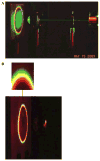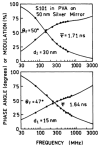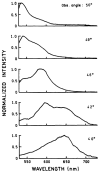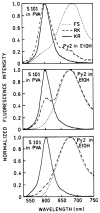Radiative decay engineering 4. Experimental studies of surface plasmon-coupled directional emission
- PMID: 14690680
- PMCID: PMC2740992
- DOI: 10.1016/j.ab.2003.09.036
Radiative decay engineering 4. Experimental studies of surface plasmon-coupled directional emission
Abstract
Fluorescence is typically isotropic in space and collected with low efficiency. In this paper we describe surface plasmon-coupled emission (SPCE), which displays unique optical properties and can be collected with an efficiency near 50%. SPCE occurs for fluorophores within about 200 nm of a thin metallic film, in our case a 50-nm-thick silver film on a glass substrate. We show that fluorophore proximity to this film converts the normally isotropic emission into highly directional emission through the glass substrate at a well-defined angle from the normal axis. Depending on the thickness of the polyvinyl alcohol (PVA) film on the silver, the coupling efficiency of sulforhodamine 101 in PVA ranged from 30 to 49%. Directional SPCE was observed whether the fluorophore was excited directly or by the evanescent field due to the surface plasmon resonance. The emission is always polarized perpendicular to the plane of incidence, irrespective of the polarization of the incident light. The lifetimes are not substantially changed, indicating a mechanism somewhat different from that observed previously for the effects of silver particles on fluorophores. Remarkably, the directional emission shows intrinsic spectral resolution because the coupling angles depend on wavelength. The distances over which SPCE occurs, 10 to 200 nm, are useful because a large number of fluorophores can be localized within this volume. The emission of more distant fluorophores does not couple into the glass, allowing background suppression from biological samples. SPCE can be expected to become rapidly useful in a variety of analytical and medical sensing applications.
Figures






















Similar articles
-
Radiative decay engineering 7: Tamm state-coupled emission using a hybrid plasmonic-photonic structure.Anal Biochem. 2014 Jan 15;445:1-13. doi: 10.1016/j.ab.2013.10.009. Epub 2013 Oct 14. Anal Biochem. 2014. PMID: 24135654 Free PMC article.
-
Radiative decay engineering 3. Surface plasmon-coupled directional emission.Anal Biochem. 2004 Jan 15;324(2):153-69. doi: 10.1016/j.ab.2003.09.039. Anal Biochem. 2004. PMID: 14690679 Free PMC article.
-
Effects of Sample Thickness on the Optical Properties of Surface Plasmon-Coupled Emission.J Phys Chem B. 2004 Aug 12;108(32):12073-12083. doi: 10.1021/jp0312619. Epub 2004 Jul 16. J Phys Chem B. 2004. PMID: 27340372 Free PMC article.
-
Surface plasmon-coupled emission: what can directional fluorescence bring to the analytical sciences?Annu Rev Anal Chem (Palo Alto Calif). 2012;5:317-36. doi: 10.1146/annurev-anchem-062011-143208. Epub 2012 Apr 9. Annu Rev Anal Chem (Palo Alto Calif). 2012. PMID: 22524220 Review.
-
Surface plasmon-coupled emission imaging for biological applications.Anal Bioanal Chem. 2020 Sep;412(24):6085-6100. doi: 10.1007/s00216-020-02635-3. Epub 2020 Apr 16. Anal Bioanal Chem. 2020. PMID: 32300846 Review.
Cited by
-
Imaging optical fields below metal films and metal-dielectric waveguides by a scanning microscope.J Appl Phys. 2017 Sep 21;122(11):113101. doi: 10.1063/1.5002071. Epub 2017 Sep 15. J Appl Phys. 2017. PMID: 30443078 Free PMC article.
-
Radiative decay engineering 5: metal-enhanced fluorescence and plasmon emission.Anal Biochem. 2005 Feb 15;337(2):171-94. doi: 10.1016/j.ab.2004.11.026. Anal Biochem. 2005. PMID: 15691498 Free PMC article.
-
Use of surface plasmon-coupled emission to measure DNA hybridization.J Biomol Screen. 2004 Apr;9(3):208-15. doi: 10.1177/1087057103262363. J Biomol Screen. 2004. PMID: 15140382 Free PMC article.
-
Directional two-photon induced surface plasmon-coupled emission.Thin Solid Films. 2005 Nov 22;491(1-2):173-176. doi: 10.1016/j.tsf.2005.06.010. Epub 2005 Jul 11. Thin Solid Films. 2005. PMID: 33828343 Free PMC article.
-
Waveguide-modulated surface plasmon-coupled emission of Nile blue in poly(vinyl alcohol) thin films.Thin Solid Films. 2006 Jul;510(1-2):15-20. doi: 10.1016/j.tsf.2005.07.312. Epub 2006 Feb 28. Thin Solid Films. 2006. PMID: 27721522 Free PMC article.
References
-
- Diamandis EP. Immunoassays with time-resolved fluorescence spectroscopy: principles and applications. Clin Biochem. 1988;21:139–150. - PubMed
-
- Lövgren T, Pettersson K. Time-resolved fluoroimmunoassay, advantages and limitations. In: Van Dyke K, Van Dyke R, editors. Luminescence Immunoassay and Molecular Applications. CRC Press; New York: 1990. pp. 234–250.
-
- White JC, Stryer L. Photostability studies of phycobiliprotein fluorescent labels. Anal Biochem. 1987;161:442–452. - PubMed
-
- Kronick MN. The use of phycobiliproteins as fluorescent labels in immunoassays. J Immunol Methods. 1986;92:1–13. - PubMed
-
- Ambrose WP, Goodwin PM, Jett JH, Van Orden A, Wemer JH, Keller RA. Single molecule fluorescence spectroscopy at ambient temperature. Chem Rev. 1999;99:2929–2956. - PubMed
Publication types
MeSH terms
Grants and funding
LinkOut - more resources
Full Text Sources
Other Literature Sources
Miscellaneous

